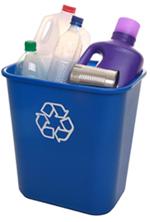 Just Say “No” to Bottled Water
Just Say “No” to Bottled Water
We all grab our bottle of water as we run out the door or to fill our glass before resting at the end of the day on the couch. But with how everyone these days grouses about the high cost of gasoline, it’s baffling how many don’t object to paying $9.85 per gallon for bottled water (based on about $1.25/pint with eight pints in a gallon).
When a consumer pays a dollar plus for bottled water, 95 percent of the cost is for the bottle, label, lid and transportation. According to the Beverage Marketing Corporation, per capita, Americans consumed 22.6 gallons in 2003, up from 10.5 gallons in 1993. So why are so many people willing to pay a premium price for bottled water? There is the perception that bottled water: (1) tastes better; (2) is cleaner and safer than tap water.
There is a passage in one community’s “2006 Water Quality Report” stating their, “… tap water has met all US/EPA and state drinking water standards.” Further, a taste test at a farmers market showed 130 participants preferred the local tap water 4-to-1 to a popular bottled water brand.
But, cost and taste aside, the key reason to avoid bottled water is the bottle itself. According to a Sierra Club report, 30 million plastic bottles are discarded each day — more than 10 billion a year. Plastic bottles have only a 10 percent recycled rate. The other 90 percent end up in landfills, in parks, beaches and along roadways.
The production of plastic, made from petroleum, a nonrenewable resource (renewable means natural resources, like solar or wind, which are naturally replenished), leads to the release of a variety of chemicals. The Berkeley Ecology Center reported most of the smaller bottles used as water containers are made from polyethylene terephthalate (PET), which generates 100 times more toxic emissions than an equivalent amount of glass. In fact, the plastic industry releases 14 percent of the most toxic industrial releases, such as styrene, benzene and trichloroethane, into the air.
Other major emissions include sulfur oxides, nitrous oxides, methanol, ethylene oxide and volatile organic compounds (VOCs).
Eleven states have bottle bills or container deposit laws requiring a minimum refundable deposit on beverage containers to ensure a high rate of recycling. Additionally, seven states have bottle bill legislation pending.
There are alternatives to buying bottled water; yes, they may take some getting use to, but they do help save the pile-up of plastic. One solution is to use a Klean Kanteen (www.kleankanteen.com) product. These 27-ounce stainless steel bottles retail for about $17.95 and are reusable, lightweight and risk-free. The bottle comes with a sport drinking cap (loop or flat) made from safe, nonleaching polypropylene plastic.
Purchase a refillable/reusable nontoxic container and take it with you to the gym, on walks, to work or anywhere else you need a beverage on the go. Become proactive and visit www.toolkit.bottlebill.org to learn what you can do. (You can also take a “No Bottled Water” pledge online at www.lighterfootstep.com/5-reasons-not-to-drink-bottled-water.)
Alternatives to Disposable Products
We live in a disposable society, and not just with water bottles. We frequent fast food restaurants, snap pictures with disposable cameras and write with disposable pens and pencils. But there are alternatives to throwaway products, and buying a good reusable pen, pencil or camera is not as costly as you might think.
Attractive, ergonomic refillable pens are available in ballpoint, rollerball or gel inks at prices ranging from just under $2 to high-end styles at $25 on up. Fountain pens are making a comeback and, while purists may choose to dip the nib in a bottle of ink, many prefer the convenience of cartridge refills. True, the empty cartridge or refill stick gets tossed, but those take up less landfill space than dozens of used plastic pens.
Similarly, by using a mechanical pencil, you can say goodbye to tiny eraserless nubs. A sharp point and functioning eraser are always ready to tackle finance or prose. Mechanical pencils come with lead refills and most have refillable erasers, too. This green choice eliminates the need for pencil sharpeners — another throwaway device.
Single-use cameras have gained widespread acceptance among consumers. Why trust your vacation or special occasion photographs to a camera that will be thrown away? Dependable cameras with built-in flashes and zoom lenses are now made small enough to carry in a purse or pocket and are available at affordable prices. Nowadays, even your cell phone can take photos. Digital or 35mm cameras not only take better quality photos, but the empty film canisters can be recycled in many communities or at camera shops.
No discussion about disposable products would be complete without mentioning razors. Broadcast and print ads show women prancing on the beach with smooth legs or performing acrobatics in the bathroom while shaving legs — each ad features disposable razors. A multitude of hair removal products exists, so using throwaway razors is not the only option. Personally, this gal keeps her gams silky smooth with a 10-year-old Schick(r) Personal Touch Razor (blade cartridge refills) and Aveda’s Rosemary Mint Shaving Gel (people, not animal, tested).
Put some thought into your everyday purchases and remember it’s easier than you think to practice the 3 R’s: Reduce, Reuse, Recycle and avoid the 3 D’s: Disposable Dumping is Dumb.
